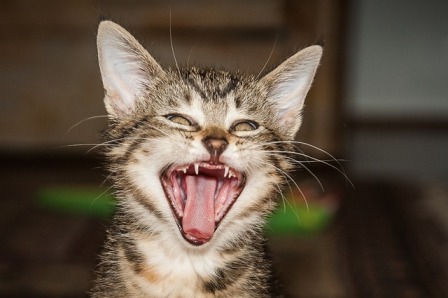How to Inspect Cat’s Teeth
How to Inspect Cat’s Teeth
Cats as natural born carnivores are equipped with teeth that are completely designed to process meat. The shape of their teeth, even their molars, is not modeled to grind plants, and their jaws do not have the ability to move circularly as in ruminants. Their jaws can move only up and down, what is ideal for cutting and chewing meat. In the wild, cats gnawed the bones of their prey, which helped them to maintain their teeth clean and healthy. Chomping bones also helped the blood in their gums to circulate better. Because of that, many veterinarians recommend feeding cats occasionally with raw chicken necks and wings, or some other piece of meat, which the cat can gnaw. Cats are, also, known, as animals who carefully hide any sign of pain. For this very reason, it is extremely hard to recognize when the cat has dental problems. When the cat’s owner notices teeth problems with her/his cats, it is usually too late. In order to prevent any trouble with cat’s teeth and find out in time if some issue has developed, veterinarians suggest inspecting regularly cat’s teeth. The article “What to Look for When Examining Your Cat’s Teeth” explains how to do it properly.
How to Inspect Cat’s Teeth
Before opening your cat’s mouth, examine the face for swelling, especially below the eyes. Frequently a broken upper fourth premolar tooth will cause an abscess that may spread below either eye. Fractures of the upper canines (fang or eye teeth) can also cause swelling on top of the nose. Next, feel around the neck below the ears. Abnormal swelling of this area can occur from infection, cancer, or inflammation.
Next, take a whiff of your pet’s breath. How? Gently pull the lips back to expose the side of your pet’s teeth and gums. If there is a foul odor, care is often needed. Since cats cannot brush their own teeth, gingivitis and periodontitis are the most common diseases affecting our feline friends. Reddening of the tissue where the gum meets the tooth may represent inflammation, infection, or trauma. In cases of advanced periodontitis, there may also be bleeding and discharge from the gums. Treatment of gingivitis consists of cleaning and polishing the teeth to remove built up plaque. Depending on the degree of periodontal disease, surgery may also be needed to remove pockets that develop around teeth. Daily brushing is usually easy and essential to control gingivitis.
Examine the teeth for fractures. Unfortunately, cats sometimes eat things that are not tooth friendly. If the object chewed is harder than the tooth, fracture may occur. Broken teeth with nerve exposure will usually result in an infection at the tooth’s tip. Food and bacteria will travel down the root and may eventually affect your cat’s heart, liver, and kidneys. Fractured teeth are treated by replacing the infected nerve with material that fills the tooth, and seals the open hole. Crowns are placed on top of the repaired teeth for protection.
Many cats older than 5 years old will have cavities. Cats’ mouths should be examined for cavities. They commonly occur at the gum line. If your cat will allow it, gently press a cotton swab to the gum line around the outside of the teeth. If your cat starts quivering and chattering, there is probably a cavity. Cavities are painful and should be either filled or the tooth should be extracted. Oral growths may be benign or cancerous. Some tumors occur at the gum line while others are found below the tongue or on the inside of the cheeks. Hopefully, immediate care may result in a cure.
It is necessary to perform this check regularly because we can notice teeth problem only if our cat stops eating. And this rarely the case with cavities, gingivitis, or broken teeth. If the cat refuses food, we can be sure that the teeth problem goes too far. In that case, it would be easy to spot teeth issues. Examining cat’s teeth regularly can also help us to discover the signs of some other, more severe diseases, such as leukemia virus, mouth tumors, kidney disease, stomatitis, etc. Bad breath, red gums, the cat losing weight, chewing food on one side of the jaw, or dropping the food are all the signs of advanced dental problems. When noticing the first sign of oral issue like drooling, bad odor, the red tissue around teeth, red gingiva, missing teeth, etc., the best option is to visit a vet. Having in mind that a majority of cats develops various teeth problems after their third year, a need for the regular check should be our highest priority.










